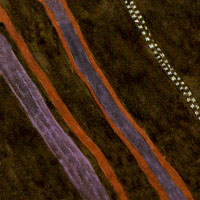| The history of the nude in Western painting - which is primarily
the history of the female nude painted by a male artist for male viewers
- is replete with the body language of sexual availability. Such is also
the case with male nudes, though here the sexual come-on is coded or usually
passes unnoticed by those not interested. Pearlstein avoids all of these
stereotypical poses and attitudes. In the nudes, unlike the portraits,
there is no "eye contact" with the viewer; eyes are downcast,
stare away to the side, or are simply not visible. |
| Because of Pearlstein's manner of working from a set of physical details
out toward the canvas or paper edge, cropping often occurs at the face,
leaving not the slightest opportunity for the traditional come-hither gaze.
Pearlstein understands what he is doing. "In the nudie magazines,"
he says, "the models are carefully posed and the camera angle is chosen
to exploit the body for certain purposes. |
 |
Nothing is casual or accidental. The only thing I do is consciously
look for how the figure moves. The choreography. How the space gets broken
up. The pose gets determined by the most interesting break up of the space,
which has nothing to do with exploiting one or another anatomical detail.
It's cold and impersonal." |
| Pearlstein once said, perhaps out of self-defense, that he
has performed a very important rescue operation. He has saved "the
human figure from its tormented, agonized condition given it by the expressionistic
artists, and the cubist dissectors and distorters of the figure, and at
the other extreme I have rescued it from the pornographers, and their easy
exploitations of the figure for its sexual implications. |